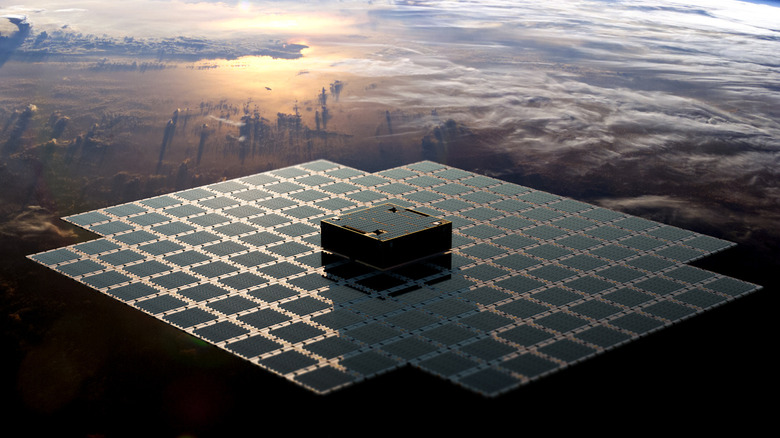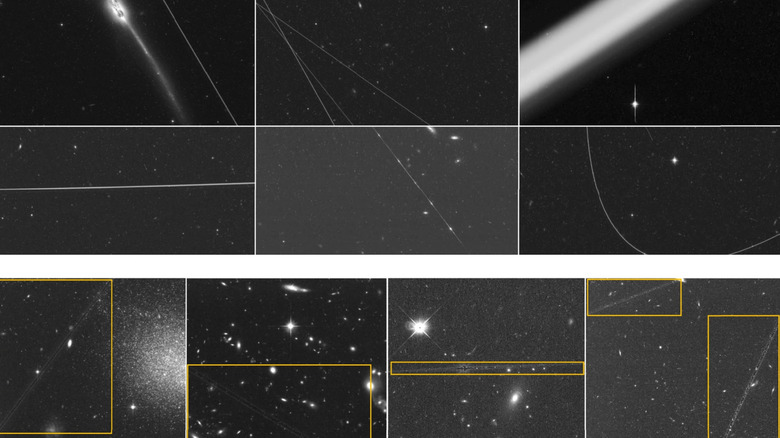This Giant Satellite Is Causing Astronomical Problems For Scientists: Here's Why
For years, scientists have been raising the alarm about the light pollution caused by satellites operating in low-Earth orbit (LEO), such as the ones launched by SpaceX for its Starlink internet service — in fact, such concerns even resulted in a petition. SpaceX has taken various measures over the years to address the problem, such as testing sun visors and an anti-reflective coating on the satellites. However, Elon Musk's company isn't the only one shipping satellites into LEO, and a new breed of giant satellites that outshine even the brightest stars have also arrived on the scene.
That giant satellite in question is BlueWalker 3, the world's first to allow a direct 5G line between a satellite and a phone. Developed by AST SpaceMobile, it unfolds to reveal an aperture spanning 693 square feet. The prototype unit entered orbit just over a year ago, but a series of commercial models called BlueBirds will soon be seen floating in the night sky. That has scientists concerned, as the prototype unit is already one of the brightest objects in the night sky.
In a study published in the journal Nature, scientists explain that they collected photos from professional astronomers as well as amateur volunteers to study the light pollution problem. The team found that the BlueWalker 3's brightness reached 0.4 apparent magnitude, which was greater than some well-known cosmic bodies such as Betelgeuse and Altair, putting it in the same league as the top 10 brightest stars in the sky.
The big light problem for astronomy
According to Imperial College London, BlueWalker 3 commands "the largest commercial antenna system ever deployed into low-Earth orbit" at 64 square meters. That's a worrying precedent for light pollution. While scientists are accustomed to seeing satellites in the course of their observations, the final images need to be digitally altered to remove the resulting streaks. When a chain of satellites — such as Starlink trains — passes by, the task becomes incredibly burdensome, as correcting those images is not easy. BlueWalker 3, with its massive reflection profile, could be dramatically more disruptive.
Technically described as artificial light at night (ALAN), light pollution is not only a source of optical interference by such large satellites but there is also another aspect of radio interference that needs to be addressed simultaneously, according to experts. An exhaustive report by the International Astronomical Union [PDF] highlights the scope of the problem and proposes guidelines for protecting the "science of astronomy" from man-made satellites. Then there's the cosmic heritage aspect. SpaceX already has the FCC permit to launch 12,000 satellites and plans to launch an additional 30,000 units. Scientists are concerned that these satellites will soon cloud the pristine view for not just them, but the average star-gazer, too.
The future of astronomy is bright
It's not just the bright streaks that are worrisome for astronomers, but also the adjacent interferences. "BlueWalker 3 actively transmits at radio frequencies that are close to bands reserved for radio astronomy, and existing observatory protections from radio interference may not be sufficient," notes Dr. Mike Peel, a researcher at the London-based institution. The experts involved in the latest study are hoping that stakeholders in the commercial satellite industry will consult with scientists to minimize the negative impacts ahead of large-scale deployment.
It seems AST Mobile is not oblivious to the concerns. The company tells Space.com that it is "collaborating" with NASA and other groups on strategies to solve the brightness issues and exploring tactics such as changing antenna geometry to ensure radio interruptions are minimized. The company has also expressed intentions to apply an anti-reflective coating on its subsequent wave of satellites to address the complaints.
Yes, already planned. We avoid use of certain lower Ku frequencies specifically for radio astronomy.
— Elon Musk (@elonmusk) May 27, 2019
Industry leader SpaceX is also making some positive strides. The Elon Musk-backed company is working with the National Radio Astronomy Observatory to tone down the negative impact of satellites on astronomy. Among the suggestions proposed are setting up radio exclusion zones so that observatories can do their job without satellite radio interference. But not everyone is convinced and many in the science community worry that the efforts being made are too little, too late.
Update 10/4/2023: A spokesperson for AST SpaceMobile has reached out to the SlashGear with the following statement regarding concerns about BlueWalker 3:
"According to the United Nations Broadband Commission, 2.6 billion people around the world are offline. At AST SpaceMobile, our mission is to democratize access to knowledge and information regardless of where people live and work. To achieve this we are building the first and only space-based cellular broadband network designed to seamlessly connect everyday smartphones. By connecting people, we aim to alleviate poverty, spur economic development, foster a diverse digital society, and save lives.
"This year using BlueWalker 3, and in partnership with leading cellular industry providers around the world, we've accomplished many historic milestones toward this goal, including the first-ever satellite direct-to-device voice calls, 4G data downloads (in excess of 14 Mbps), and 5G connectivity.
"While other constellations may require thousands of satellites to achieve their coverage goals — there could be as many as 58,000 in orbit by 2030, according to a recent US government report — we plan to provide substantial global coverage with around 90 satellites.
"Solving significant problems for humanity often comes with challenges. In this case, we are working to address the concerns of astronomers by:
- Collaborating with NASA and certain astronomy working groups to develop advanced industry solutions, including potential operational interventions.
- Avoiding broadcasts within or adjacent to the US National Radio Quiet Zone (NRQZ) and other radioastronomy locations as required or needed, including those not officially recognized.
- Planning to position gateway antennas at a considerable distance from the NRQZ and other radio-quiet zones vital to astronomy.
- Using roll-tilting flight maneuvers, which significantly reduce apparent magnitude.
- Planning to equip our next-generation satellites with anti-reflective materials.
- Sharing detailed ephemeris or celestial location data to help astronomers plan observations."

